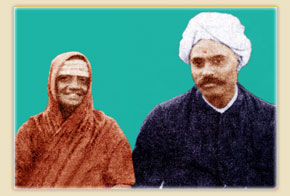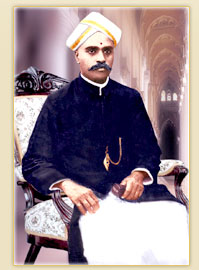
|
 |
| After successfully passing out from the Madras Medical College, Dr. Nanjunda Rao set up his practice in Cutchery Road, Mylapore, primarily a locality of lower and upper middle class people in Chennai. The way he treated his patients with utmost care earned him a very good name and his practice flourished soon. Unlike other allopathic physicians, Dr Rao combined the native medicines also after experiment in treating his patients. His talents earned him laurels that drew big land lords and the elite as well as Englishmen holding higher posts in the government to be his regular customers. He became the family doctor to all these people of higher strata and his income soared high very shortly. On hearing his proficiency, the king of Mysore princely state invited him to be the physician of the Palace. Dr Rao politely declined the offer saying that he would attend to the royal family and others in the palace whenever there was the need while he continued his practice at Chennai. It was Chennai that made him a physician and therefore he should pay back his gratitude to the people of Chennai, was his motto. |
| Dr. Nanjunda Rao was a staunch nationalist. He entertained all political leaders including fiery freedom fighters like Bipin Chandra Pal and Bal Gangadhar Tilak at Sasi Vilas, his palatial home in Mylapore, without fear or hesitation because in those days, the British were ruling the colonial India and Dr Rao was also holding office as Chemical Examiner in the government laboratory. He was in contact with militant leaders like V VS Iyer and the national poet Subramania Bharathi. Dr. Rao’s Sasi Vilas was home for Sarojini Naidu, who was hailed as the nightingale of India, whenever she visited Chennai. Dr. Rao built a separate building behind his house for the convenience of his guests, calling it ‘Grace Lodge.’ |
| Dr. Rao was connoisseur of arts and crafts. He took fancy in building large villas with same pattern, painted red. Thus, buildings constructed by him were identical and people would say, “Oh, this is Dr. Rao’s,” whenever they saw an aesthetically built red palatial house in the City. |
| Dr. Nanjunda Rao was also devout and highly spiritual. He was one of the first rank disciples of Swami Vivekananda, who visited Chennai in 1893. Vivekananda was in contact with Dr Rao even when from America and on his tour of Europe, advising him about bringing out a magazine to propagate spiritual and cultural ethos of ancient India. When Vivekananda returned with active support of the West for his mission, he asked Dr. Rao to help him in establishing a mutt in Chennai in the name of his master Sri Ramakrishna Paramahamsa. Swami Vivakananda’s disciples continued to have Dr.Rao’s association even after Swamiji’s Maha Samadhi. It was Dr. Rao who helped them substantially to establish Sri Ramakrishna Mutt in Mylapore Chennai. |
| Once, Dr Rao had to go to Komaleeswaranpet monastery to treat a person by name Arunachalam. He was the brother of Shri Sakkarai Amma. By then Shri Sakkarai Amma had fully blossomed into a spiritually exalted soul, always experiencing the Bliss and expressing her happiness by frequent loud laughter. When enquired, people in the house told him that there was a mad woman living in the upstairs, not communicating with them but simply laughing aloud frequently and meaninglessly. |
| Dr Rao, during his visits to Komaleeswaranpet, sometimes noticed her at the entrance of the Komaleesdwara Temple sitting on the floor and laughing at the passers by. Initially, he also took her to be a mentally deranged person. Later on, out of curiosity, he initiated communication with her and found she was really a great soul deserved to be revered and respected. He became her disciple in course of time. Though Amma was an unlettered poor Brahmin widow, Dr Rao did not hesitate to openly declare she was his mentor and guru. He took her along with him on all his pilgrimages. He consulted Amma on every matter, domestic or otherwise and found her guidance extremely rewarding. He understood that Amma was an Upasaka of Sri Chakkra and started addressing her Sri Chakkarathamma (Mother of Sri Chakra). It soon became ‘Sakkarai Amma’ in people’s language meaning Sugar (Sweet) Mother, more apt to the characteristics of Amma! This prompted Dr. Rao also to refer her as Sakkarai Amma! |
| When Sakkarai Amma revealed that she would give up her physical frame soon, Dr Rao did not take it seriously. How can you go away from us, he would react. When she actually discarded her mortal remains in February 1901, it was a rude shock to him. However, he gathered strengths and arranged a big procession to carry the mortal remains to the place he had already bought in Thiruvanmiyur at the instance of Amma earlier, and advising him to bury her remains at the spot on her demise. Dr Rao built a temple on the site where Sri Sakkarai Amma was laid to rest and made arrangements for the upkeep of it. He founded a trust for the upkeep of the temple. |
| Leading a hectic life, Dr. Rao developed high blood pressure and other ailments. Overlooking his health and personal care, he continued to engage in several public causes besides attending his patients and taking part in spiritual activities. Suffering a stroke due to high blood pressure, he expired on January 04, 1921. He was just 59 when the end came. |
| The curtain dropped on the action-filled life of Dr. M.C. Nanjunda Rao, ensuring permanent rest for an illustrious soul that was always engaged in some public cause, and in an attempt to imbibe spirituality among people for a peaceful and contented life spreading harmony and love. No doubt, Dr Rao’s soul would have rested finally at the lotus feet of his Guru Shri Sakkarai Amma. |
| As Dr. Rao was totally drawn toward his Guru Shri Sakkarai Amma physically and mentally, and likewise, the Guru Shri Amma was very fond of her prime disciple Dr. Rao, his mortal remains were also laid to rest inside the temple premises in a separate enclosure near Shri Amma’s abode; a bust size statue of Dr. Rao was installed later on at the site where he was laid. |
